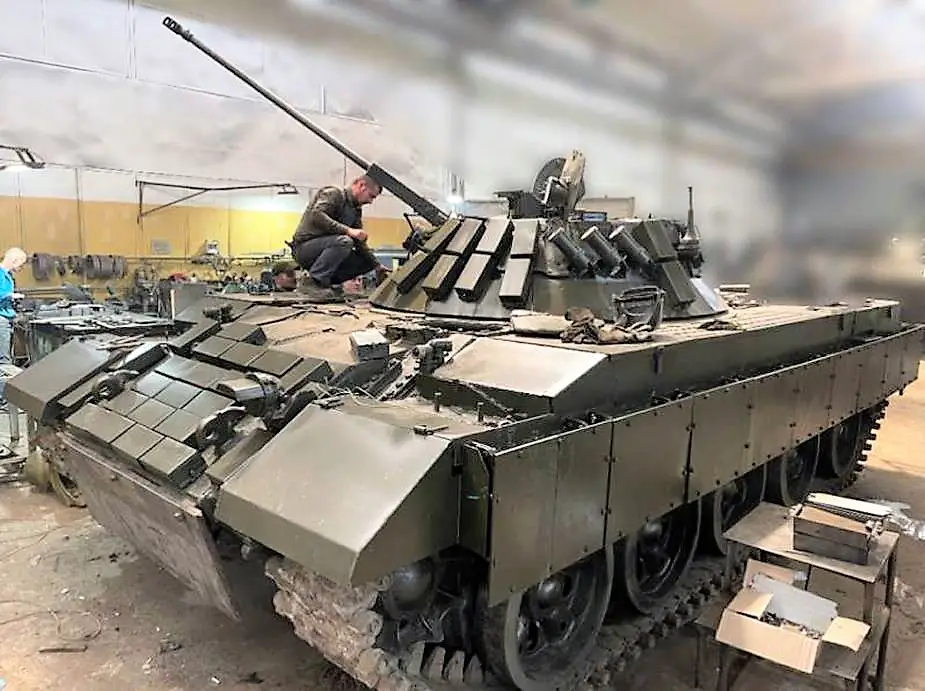Ukrainian volunteers complete prototype of heavy IFV based on T-62M tank
Topwar.ru website reports that the new heavy infantry fighting vehicle was created on the basis of a Soviet-era T-62M tank, allegedly captured by Ukrainian soldiers on a Russian unit, and handed over to volunteers. A turret from a Russian infantry fighting vehicle BMP-2 with a 30-mm automatic cannon has been fitted to the hull of the tank.
Follow Army Recognition on Google News at this link

Ukrainian "volunteers" are completing the development of a heavy infantry fighting vehicle called ‘Punisher’. It is also a fire support vehicle. The prototype is ready for testing (Picture source: topwar.ru)
The turret and front of the hull of the product have been covered with active reactive armor "Contact-1". In the future, the volunteers plan to extend the protection to the entire hull, including the aft. It is assumed that this protection will be able to withstand the anti-tank weapons used by the Russian army.
This vehicle, called the "Punisher", must also carry a squad of military personnel, but this function is not provided in the first version (prototype illustrated here). Should the project prove efficient, the work would then be further developed.
The ultimate goal of this project is to create a heavy infantry fighting vehicle capable of delivering infantry to the front line under enemy fire. Volunteers are confident that they will definitely succeed in doing what the design bureaus of large enterprises producing armored vehicles could not or did not develop so far since Ukraine's independence.
As it appears from the picture, the T-62M chassis has been reinforced by an armor plate bolted at the bottom of the glacis to better protect the lower part of the tank, and armor plates have also been bolted on the sides to create spaced armor, an old solution dating back to World War 2 when the Germans developed this method on some of their tanks and tracked assault guns. The original front fenders have also been replaced with thicker and more enveloping steel ones. The entire top platform appears to have been raised by a few centimeters but without leaving a clue about the use of this height extension. The drive train remains the original one.
The BMP-2 turret is constructed from thick armored plates, offering enhanced protection against small arms fire, and shell fragments but not modern anti-tank weapons, hence the added reactive armor boxes. The turret's sloped surfaces are specifically designed to deflect incoming projectiles.
At the heart of the turret is a powerful 30mm autocannon, known as the 2A42. This cannon is capable of firing a variety of ammunition types, including high-explosive incendiary, armor-piercing, and fragmentation rounds. It has an effective range of up to 2 kilometers, providing the BMP-2 with significant firepower against both armored and soft targets. The cannon is stabilized, allowing for accurate firing on the move and from uneven terrain, enhancing the vehicle's combat effectiveness.
In addition to the autocannon, the BMP-2 turret is equipped with a coaxial machine gun, typically a 7.62mm PKT. This secondary weapon serves as a support weapon against infantry, light vehicles, and low-flying aircraft. The coaxial machine gun is synchronized with the main cannon, enabling both weapons to engage targets simultaneously.
Unlike the original Russian BMP-2 turret, the Punisher's one does not include (maybe not yet) a launcher for the 9M113 Konkurs or 9M111 Fagot anti-tank guided missiles (ATGMs).
Furthermore, the BMP-2 turret incorporates various sighting and targeting systems to enhance its accuracy and effectiveness. These systems often include a day/night thermal sight, laser rangefinder, and ballistic computer. No information is available yet about the systems that will be mounted by the Ukrainian volunteers.
Defense News June 2023





























